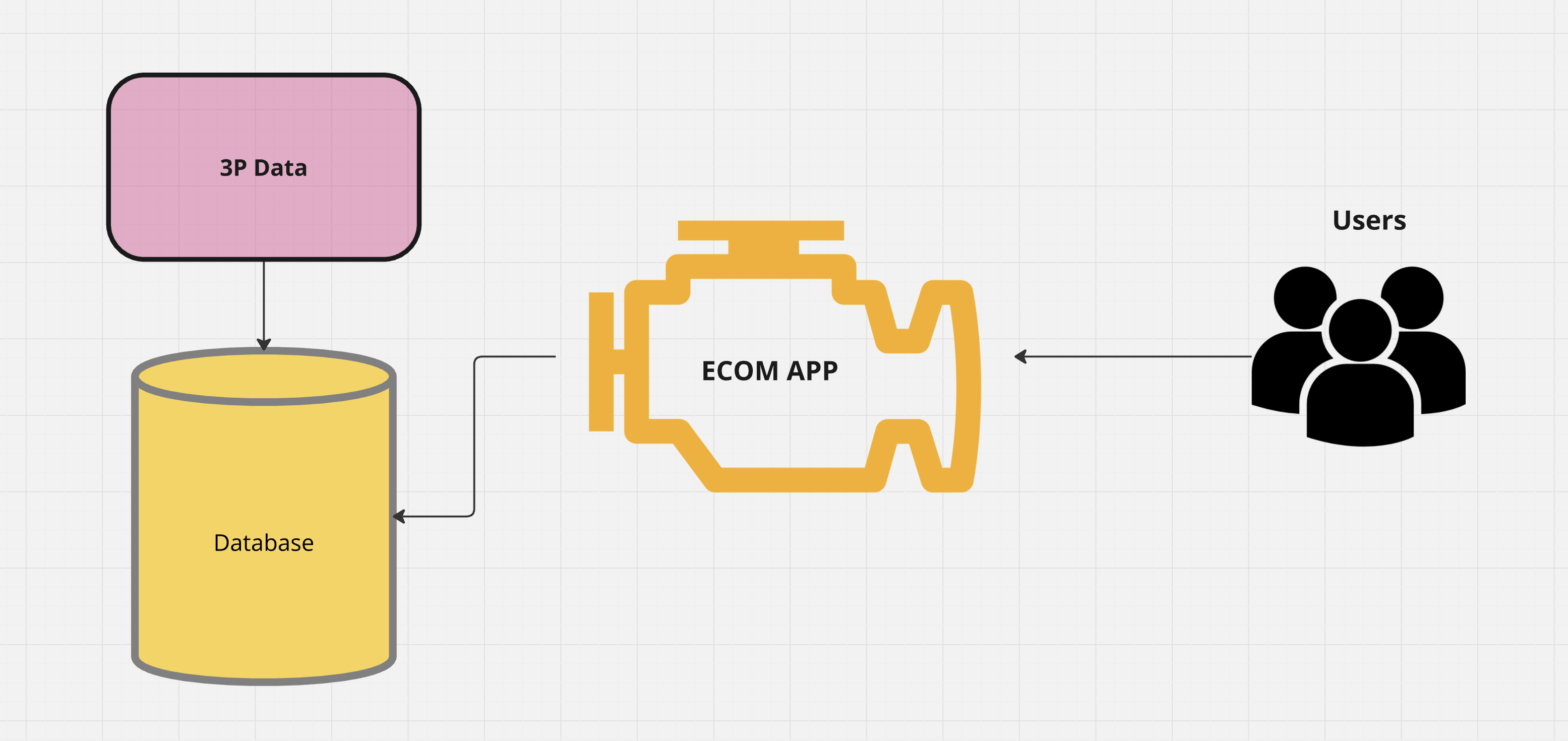
I was sketching out architectural recommendations for a client project that, after a successful POC, was ready for the prime-time of production software. I stopped to ask myself why the new arch diagram I was creating looked vastly different from the architecture of the existing concept software; even when my answers seemed solid (they included specific measures of reliability, speed, scale, and security), I could not shake the feeling that this felt familiar in a bad way. I counted the number of replatforms I have either been directly responsible for (i.e. several Modern Data Stack conversions) or indirectly impacted by (Data Warehouse reconciliations between the “old” and “new” systems) over the last fifteen years. I came up with thirteen replatforms. Of those thirteen, only four eventually yielded positive product or engineering outcomes; that is a roughly 70% failure rate among replatforms I have personally witnessed. It is no wonder that anything resembling a re-write, re-architecture, or re-thinking gives me immediate pause.
Replatforms are resource-intense, time consuming projects that can make or break executive careers, mark the hockey stick inflection point for an organizations’ growth, or leave permanent scars in the relationship between business and technology. They usually begin with excitement and hope, but far too often end with frustration and resentment. It is worth looking deeper to truly understand what is going on in a replatform, and what can potentially go wrong.
What counts as a replatform?
The exact boundaries of what would constitute a replatform are a bit fuzzy, and the distinction between a replatform, refactoring, and the natural evolution of features within a code base can be hard to define. In theory, a replatform is the decision to tear down or replace existing software with something entirely new. This new element could be a change in software framework, a total shift in architecture, or translation into an entirely different programming language (or all three at once!). In the physical world, replatforming would be analogous to bulldozing a derelict building and constructing a new one where the original building had stood. Just like in the real world, developers often play semantics to navigate politically; where the home builder in our real-world example might leave a few feet of the original foundation intact in order to file remodel permits and avoid new construction fees, a software engineering team may leave trivial processes running on the legacy system to avoid a potentially negative replatform label.

For purposes here we will use replatform to mean any project where the bulk of an application’s business logic is migrated to a new framework, architecture, and/or programming language. Contrasting replatforms are refactors, where the existing application is re-written (in part or in full) in the same language, framework, and architecture, without changing the externally perceivable functionality of the application. It is worth noting that a refactored application may be modified as a side effect of a refactor - pages may load faster, function more reliably, or cost less to operate - but these improvements are fallout from a refactor’s primary concern of making the codebase better.
Replatforming is Expensive
All software has a cost. What makes the cost of a replatform so much more painful than feature investment is that there is often no perceivable difference to the business after the cost is incurred. The legacy software did X and Y, and after a $2Million replatform project, the software still does X and Y. That $2 Million got you to the potential for new feature Z, which was hypothetically difficult or impossible while still on the legacy platform. A common mitigation strategy is to pork barrel a replatform in with highly desired features, making the cost that much more palatable. “We will need to rebuild the app if we want feature Z” links the considerable time and cost of the replatform to feature Z, not the replatform itself.
Why Do We Replatform - on the surface
There are common themes that typically lead to the conclusion that a replatform is in order. You can expect to find variations of these in a roadmap deck that is calling for replatforming investment:
The legacy application is slow, unreliable, expensive, and old
Our engineering team wants a fresh start to do things right
The legacy programming language or framework we are using is dated and hard to hire for
We can’t do the things we want to do with the legacy language/framework
There are performance issues we cannot overcome with the legacy application
We want to ship a new feature and need to replatform to do that
These are the reasons we do talk about when discussing the massive time and resources investment that is a replatform. But what are the hidden motivators?
Why Do We Replatform - under the skin
There are many unspoken motivators for a replatform, and these are the ones to be most aware of and challenge the most boldly.
Reign of the New King
Replatforms often coincide with a change in engineering leadership. Just as a new POTUS will hand-pick their cabinet and implement policies that reflect their views, a new Director of Engineering or CTO will often populate the engineering team with “their people” - engineering managers and developers from their existing circles. Once they have assembled a familiar team, they will often replatform applications to an equally familiar programming language and framework. This also creates a historical divide between the new platform and the “old software” - legacy code with faceless owners that can be much more easily blamed and discredited.
Preferences Among Engineers
It is not surprising that if you are fluent in Spanish, you might try to get everyone to speak Spanish. This is often the simple motivation behind a replatform. “I know Ruby on Rails, so why don’t we just re-write the app in RoR?”
There is a particularly sneaky strategy to replatforming that is derived from this motivation, and which I’ve witnessed first-hand several times. An engineer who is not a huge fan of the existing language or framework brings up their preferred platform, qualifying the suggestion with “but hey, I’m a computer scientist and the language isn’t important, I’ll write in whatever makes sense to everyone.” Shortly after, they create a new codebase using their preferred language and framework, and begin implementing new features in this codebase as an “auxiliary service” to the existing application. “I’m just going to do auth/caching/whatever in this one, but hey the real service is still the ‘old’ platform.” Finally, the engineer begins duplicating existing functionality, and in every meeting they lead with “Why don’t we implement that in the new platform instead?” Beyond the dishonesty and generally gross nature of this technique, it has the added effect of committing the organization to an expensive, time-consuming replatform without the knowledge of leadership. I mention it because it is a disturbingly common pattern that should be avoided at all costs.
The Distant Mountain

Everything looks much easier from far away, just as a distant mountain appears tiny when compared to the hill you are currently climbing. Existing platforms have likely handled all the easy challenges long ago, leaving the day-to-day efforts of engineers grounded in the remaining, most difficult problems. It is tempting to believe that “changing mountains” will make everything easier - and for a while it absolutely will. Instead of adding new value by solving hard problems, engineers get to re-solve the easy problems in a different language or a new framework. Of course by the time the replatformed application has reached the same level of complexity and handled the same business cases as the legacy application, the problems will be just as hard, and the business will have gotten no value from the efforts.
Politics
This is a surprisingly common motivator for replatforms, especially in larger organizations. A team owning a platform or ecosystem may be difficult to work with, and other engineers may attempt to replatform rather than deal with them. or a shift to a novel platform may be seen as an opportunity for a leader to grab power within the organization.
Novelty, Group-Think, FOMO & Shiny Object Syndrome
The world of software engineering evolves at a breakneck pace, and as engineers we are expected to stay close to that bleeding edge. The industry is not kind to those that allow their skills to stagnate. Over time, most engineers learn to balance an awareness and appreciation for new languages, frameworks, patterns etc with the compound interest created by stable software, incrementally improved. However the dreaded “shiny object syndrome” is never too far behind; that excitement created by new software that can leave a codebase in a perpetual state of identity crisis.
Closely related to this is the group-think specifically around software performance. Engineers can easily fall into the trap of comparing arbitrary (and most often meaningless in practical terms) language and framework performance specifications, most notably around speed. They compare esoteric performance benchmarks the same way muscle car owners lined up in a car show spar with horsepower stats. This can lead to very emotional, competitive decision-making where replatforming is concerned, and leave your company with the substantial bill for a 1200hp racecar that sits in gridlock traffic every day.
Boredom
Engineers are stimulated by solving complex problems. The job is often exceptionally mentally taxing, and it requires the dopamine hit of learning and accomplishment of success to balance out that strain. A veteran engineering team is an invaluable asset - they know your application code inside and out, are aware of the history and the limitations, and are exceptionally tuned to the needs of the business. But they are likely also a bit envious of colleagues that are learning new things, experimenting with new languages, and expanding both their skills and the range of possible accomplishments. A replatform is often a chance for well-settled engineers to get outside their comfort zones without heading to another organization.
Career Stagnation and Fear of Obsolescence
Closely linked to boredom is the fear of stagnating. Hiring managers often (unfairly in many cases) associate less-fashionable frameworks and programming languages with less desirable candidates. There is also the empirical factor of market share; as the footprint of a framework or language shrinks within the software world, the demand for engineers with that pointed skill set decreases. In a world where the worldwide average tenure for a software engineer is less than 18 months, it is understandable that engineers may vie for a replatform that will make them more marketable in the future.
Logical Fallacies of Replatforming
Some common justifications for a software replatform are blatantly incorrect, and rely on either a lack of or intentional disregard for subject matter understanding to persist.
Software is Content, Not a Depreciating Asset
Most roadmap decks include an architecture diagram that looks something like this:

We often use motors to represent our “workhorse” business applications because that mirrors an industrial model we can understand. And yes, our applications do run on physical hardware - servers and disk drives and devices - that wear out over time. But it is a false analog to imply that the software has worn out - that simply is not how software works. Software is instructions to a computer, stored as text, and text is content - like song lyrics or a novel. Shakespere’s Romeo and Juliet has been read likely billions of times by billions of people over the last 400 years, and yet the prose is as impactful today as the day it was written. While many of the printed copies may have worn to dust, this has had no impact on the play itself so long as it continues to be replicated. Your application software is not something that wears down with use, and it does not need to be regularly replaced like a hot water heater or a lawnmower with a finite usable life.
You Can’t Get There From Here
All programming languages eventually compile down to the same machine instructions, just like all human languages eventually compile down to the same inner-cognitive understanding of the world. The argument that you can only accomplish a certain task in a certain programming language is false, and the extrapolation of that argument - i.e. “we need to change languages/frameworks before we can implement this feature” is by extension false.
That is not to say that one language cannot be remarkably more suited for a challenge than another; it is likely much more effective to write a collection of famous French love poetry in the French language than, say, Mandarin Chinese. But to say such a thing is impossible, that is simply not true.
Newer is Better
Iterative improvement is a core to software development. We learn from experience, and as such software tooling generally exists somewhere along an upward trend line of faster, more reliable, more secure, and easier to work with. It is easy to assume, then, that newer software will always be all these things over its predecessor.
But the difference between new and old is often more about the effort to get there than the end product. It is not that older software is inherently less secure than newer software, just that it is likely easier to get to the same level of security when starting from scratch. Legacy software already exists, and the amount of effort required by that software’s creators is irrelevant. Maybe the older framework takes 200% more coding effort to perform at the same speed as the newest framework, but 175% of that work is already done. The 25% of effort invested today is still far less than the 100% of effort required to replatform. And there is no future-proofing here; the newest framework will soon be dethroned by another novel framework, and your replatformed application will require that same 25% effort to keep up - such is the perpetual cycle of software development. While good incremental improvement to a long-lived codebase can result in a remarkably hardened and resilient application, one that reflects years (even decades) of accumulated learning and adaptation, leaping from trend to trend is an excellent way to perpetually re-invent a software wheel.
Replatform Red Flags
Whether you are considering a strategy that centers around an application replatform, or you yourself are proposing such a replatform, the following can be warning signs of a project that may be ill-conceived (or at least ill-advised).
The Word “Modern”
Such as “updating to modern technology” or “moving to a modern framework.” Modern has become an executive-deck-safe way of saying “new and shiny” and should be concerning if not immediately followed up with meaningful reasons for why new/modern is desirable.
Poor Quality Issues Dressed Up as Framework/Language Issues
Reliability is very rarely a symptom of a specific software language or framework, and much more often a reflection of poorly written software. Neither are lack of test coverage, memory leaking/crashing processes, painfully slow performance, or difficult to read spaghetti code likely to be the inevitable result of the legacy platform language, framework or architecture, any more than a poorly written legal document is the result of the language it is drafted in or the paper it is printed on. Pointing out flaws in implementation is a straw man argument against a platform; these issues may be corrected as a collateral benefit from a replatform, but a replatform is rarely the cheapest, fastest, easiest, or only way to resolve them.
Features as Implied Outcomes of Replatforming
This is another false relationship used to justify a desired path. “We want to replatform the app to Python/FastAPI so we can integrate OpenAI agents into the dashboard.” From a technical perspective, the OpenAI API does not care what language you are using to make requests. The difference in technical lift to connect a Perl application or one built on Rocket from one written in Python is trivial, and yet when pressed the answer is usually that “Machine Learning stuff is all written in Python” which is an oddly common view. It is true that the hiring pool of data professionals with ML experience and Python chops is much greater than that of Rust or Perl, but that is a very different argument and one that should be addressed on its own merit.
Alternatives to Replatforming
Refactoring
This is very often the last thing engineers want to hear, and also very often the right answer. Code that is brittle and untested can be rewritten to be resilient and trustworthy. Code that is slow can be redesigned to be fast. True hard-limits of the framework can be isolated and outsourced to other services, quality can be systematically improved. The catch to this is that the business needs to recognize and account for the refactoring cost, which is often easier said than done. It is often oddly easier to get buy-in for a 12 month replatform project that will cost $3M than a 6 month refactor that costs $500k, even when the result of the latter is much more likely to meet the needs of the business; it is that consumerist logic that we would rather pay much more for a new thing that might work than pay much less to clean up our existing thing and get what we really want.
Reskilling
Almost every engineer I know that says “I’m a programmer, the language doesn’t matter” will then fight tooth-and-nail to use the language and framework they prefer (myself included). This is in part because everyone likes being an expert and nobody likes being a novice, and shifting away from your strongest toolset forces you to go through the learning and development process again. However most good engineers also want to continually expand their skills, and becoming an expert in a legacy language or framework can potentially offer just that experience. If your organization has just acquired an application written in COBOL or Lisp, the most cost-effective and rewarding solution might be to upskill your team to support the software. The caveat to this is that, once again, the business needs to account for the cost of resolving this skills gap with time and training. This can be as difficult a sell to leadership as refactoring; there is often a false assumption that developers alone should bear the burden of upskilling, which is how replatforms can come to be presented as the only alternative.
When Replatforming is the Right Answer
When the Talent Pool Dictates
When a language or framework falls out of favor, the risk is two-fold. Engineers no longer want to invest in learning and mastering the platform, which in turn reduces the size of the talent pool available to hire. As it becomes harder (and therefore more expensive) to hire people to work on your application, and the people you have are less interested in working on it (and more likely to leave for a more attractive stack), the prudent solution might be to replatform to something more ubiquitous.
When the Team Dictates
In a large organization with nearly homogeneous software tooling, a single rogue application written in a different language or framework can be a disproportional expense to the business. In this case it may make more sense to port the application to be in line with the rest of the org, rather than burden your teams to learn an additional stack.
When Concrete Limitations Are Reached
There are situations where a given framework has firm limitations imposed to allow for conventions, and those conventions no longer meet your needs. Low-code platforms, for example, may begin to choke when complex authentication or multi-zone, multi-regional redundancies are required. On-prem architecture suffers from a multitude of limitations that are virtually non-existent in cloud computing. In these cases it may not impossible to expand the existing framework or architecture to meet your needs, but fighting against the baked-in conventions, system limitations, and expense profiles can make the cost of not replatforming much greater than the return.
Extremes
Facebook famously reached the limits of GIT version controlling and replatformed to Mercurial. Google has developed proprietary storage and distributed search technologies that support operations of Google-scale, and are certainly not their original technologies. There are situations where performance at extreme scale does matter, and in those cases language and architecture choices are critical. It is important not to confuse these extremes with a painfully slow website that could be fixed with a $500 bump in cloud compute or some refactoring of a careless while-loop, both of which are much cheaper than a replatform.
When You NEED to be Cool
Replatforming just so you can use the hippest new framework may be foolish and impulsive. But there are also a lot of investors out there that are, by definition, foolish and impulsive, and the hippest new framework may be exactly what they need to see to feel good about taking the lead in your next round. Technology isn’t always about technology. Edison didn’t build the electric chair to run on AC because it was the right technology choice, he did it to paint his competitor (Nikola Tesla) as selling a dangerous product. If you need to appear bleeding edge as part of your overall business strategy, nothing says that better than a bleeding-edge replatform.
When You Really Want To, And Are Willing To Pay The Price
I was privy to one replatform that was not about performance, or profitability, or any technical drive for improvement, but about human interest. The organization had been through several years of M&A that resulted in a mishmash of applications, managed by five disperate technical teams across the globe. The CTO and owner wanted to bring the disjoined company and teams together, and he did so with a massive replatforming effort that spanned nearly two years. The end result was a singular application that was “owned” by everyone in the organization, but also a new culture that was far more cohesive. In this case, the cost of the replatform was also the price of healthy cultural growth.
So, Did We Replatform?
Reflection amongst myself and the client team helped us steer clear of a ground-up replatform. Instead we devised an iterative release of production features, coupled with small, surgical refactorings. Initially that means only a single operation will be executed in our new framework - an operation that will be trivial to implement in the new framework, but has been very complex and unreliable in the legacy platform. Once that feature is successfully released, we will address individual operations lacking in performance, test coverage and observability with targeted refactoring. This may result in our porting additional other operations to the new framework where the end result will be cleaner, more performant, more maintainable code - but the replatforming is a side effect of the feature release cycle, not the other way around.
If your team is considering an application replatform, I suggest that time spent considering the motivations, consequences, and alternatives is time well spent.